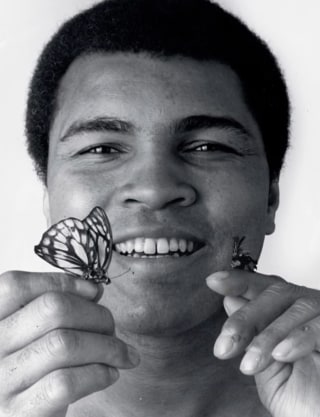Today's blog was written by Morgan Smith. Morgan is a student in the Social Foundations of Coaching course taught by Play Like a Champion Today founder and directors Professor Clark Power and Kristin Sheehan. Morgan is a senior marekting major at the University of Notre Dame.
Muhammad Ali. The most notable boxer to ever enter a ring. He is a household name, renowned for his battles outside the ring as much as those fought inside it. So how do you know the most famous boxer in the world? Not the way you should.
 |
| photo courtesy of biography.com |
You may recall his controversial persona. Ali earned a reputation for his cocky attitude, often writing poems detailing his own greatness or belittling his opponents. This, of course, pales in comparison to his shocking public announcement of his conversion to Islam in 1964, the day after winning his first heavyweight title. Cassius Clay joined the Nation of Islam, officially changing his name to Muhammad Ali and refusing to respond to any other name thereafter. Refusal became a pattern for Ali during the Vietnam War draft. Citing his religious beliefs, Ali refused to enter the draft. He was eventually tried and found guilty of draft evasion, after which he was stripped of his heavyweight title and banned from boxing for the next three and a half years. Luckily for Ali, the Supreme Court overturned his guilty ruling on June 28, 1971, acquitting him of draft evasion. Muhammad Ali went on to clinch two more heavyweight titles.
 |
| photo courtesy of NBC News |
I’ll ask the question again: how do you know Ali? Probably not as a humanitarian, right? Yet, that is exactly what he is. Muhammad Ali stands as one of the most charitable athletes in history. He has provided 232 million (yes, you read that correctly) meals to starving persons throughout the world. He has spent months in countries like Indonesia, Mexico, and Morocco, hand-delivering food and medicine to children. In the United States, he has continued his mission of charity by visiting hundreds of soup kitchens and hospitals, participating in Make-A-Wish Foundation and the Special Olympics. He even founded the Muhammad Ali Parkinson Center. Ali has received numerous awards and recognition for his philanthropic efforts, including the Presidential Medal of Freedom and Amnesty International’s Lifetime Achievement Award.
So, why don’t we know Muhammad Ali for his beautiful and charitable spirit? Why do we know him for his controversial involvement and athletic feats? I don’t have an answer for that question; and that is the problem.
Charles Barkley once said the now infamous line: “I am not a role model.” Well, that didn’t go over well. Our society looks to the men and women of sports as role models for ourselves and for our children. We want to be like Mike. We watch in absolute awe of LeBron’s 61-point game or Peyton’s seven touchdowns. But when they slip up, all hell breaks loose. Dwayne Wade’s “lovechild” scandal graced several tabloid covers. Richard Sherman’s infamous interview flooded SportsCenter for weeks. So, where’s the rest of it? Where are the news stories detailing Sherman’s work with underprivileged youth? They’re nowhere. We ask these athletes to be our role models, yet we never acknowledge them for it. We sweep the good stuff under the rug and run a highlighter over the indiscretions.
Muhammad Ali’s legacy leads us to a very stark realization: Maybe the athletes aren’t the problem. Maybe it’s us.
